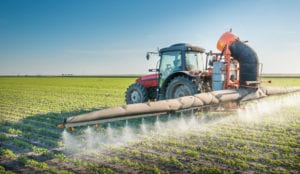Written by Marcia J. Egles, MD. Of the 800 participating subjects, those with occupational exposure to herbicides, particularly glyphosate, and fungicides had a 4 times increased risk of developing melanoma, while those with occupational exposure to pesticides for 10 or more years had a 7times greater risk compared to those who were not exposed.
 A multi-centered study from Italy and Brazil found an increased risk of melanoma among workers with occupational exposures to sunlight and pesticides 1. Melanoma is a skin cancer which can easily metastasize and potentially be deadly. Since early detection of melanoma offers the best opportunity for cure, the study seeks to identify persons at high risk, as a strategy to reduce the mortality of this disease. The prevention of melanoma by the lessening of risk would also be valuable.
A multi-centered study from Italy and Brazil found an increased risk of melanoma among workers with occupational exposures to sunlight and pesticides 1. Melanoma is a skin cancer which can easily metastasize and potentially be deadly. Since early detection of melanoma offers the best opportunity for cure, the study seeks to identify persons at high risk, as a strategy to reduce the mortality of this disease. The prevention of melanoma by the lessening of risk would also be valuable.
Worldwide in populations of European origin, melanoma has been the most rapidly increasing cancer with incidence rates rising fivefold within the past 30 years 2. Known risk factors for the development of melanoma include fair complexion, high number of freckles or moles, family history of skin cancer, and over-exposure to UV radiation, that is, sunlight. UV radiation has long been recognized as the most important environmental risk factor for melanoma, but it does not appear to fully account for the increases in melanoma’s incidence 3.
The purpose of this study was to examine the possible role of other environmental risk factors, such as pesticides, which might be contributing to the development of melanoma. Earlier research has suggested that pesticides, particularly herbicides and fungicides, may be involved 4,5.
The study examined the association between occupational exposure to pesticides and cutaneous melanoma, while controlling for potentially confounding factors. A pooled analysis of two case-control studies was conducted in two different geographic areas (Italy and Brazil). A total of 800 patients, 45% males and 55% females, with an average age of 53.9 years, participated (399 cases and 401 controls). All the participants were interviewed and received complete skin examinations by experienced dermatologists with specific training for the study. The participants’ recollections of sun exposure were validated by skin damage assessments (p less than .0001).
Forty-seven subjects reported exposure to pesticides in their work. Pesticides included herbicides (predominantly glyphosate), insecticides, and fungicides. The overall frequency of occupational exposure to pesticides among cases was 8.8% and among controls 3.0%.
The study extensively controlled for variables such as age, skin type, number of skin nevi, number of sunburn episodes in childhood, and family history of cancer. The study found that those with outdoor occupational exposure to sunlight had a risk of melanoma with an OR (odds ratio) of 1.34: (95 % C.I..90-2.00). Those who occupationally “ever” worked with pesticides of any sort had a stronger risk of melanoma (OR 2.58, 95%C.I. 1.18-5.65) compared to those not exposed. Insecticide use was not shown to be associated with melanoma, but herbicides and fungicides were associated with a fourfold increase (O.R. 4.04: 95 % C.I. 1.20 to 13.6). The most common herbicide in the study was glyphosate. Those who used pesticides occupationally for ten years or more had a sevenfold increased risk (O.R.: 7.40, 95%C.I. 1.91 to 28.7) as compared to those who were unexposed.
The researchers considered that pesticides and sun exposure might be linked by the use of sunscreen, which could increase the absorption of pesticides into the skin. However, when the data was controlled for the use of sunscreen, the effect of the pesticides remained unchanged. An alternative explanation linking pesticides and sunlight might be that the sun might heat the skin and induce sweating. Both the heat and the sweat might promote the absorption of pesticides into the skin.
The study concluded that those occupationally exposed to sunlight and pesticides may be at higher risk for melanoma. The authors felt, while more research is ongoing, that “a precautionary public health safety policy for the risk of melanoma associated with pesticides may be advisable” 1.
Source: Cristina Fortes et al, “Occupational Exposure to Pesticides with Occupational Sun Exposure Increases the Risk for Cutaneous Melanoma”, JOEM: vol. 58, Num. 4, April 2016.
Copyright © 2016 by the American College of Occupational and Environmental Medicine
Marcia Egles, MD, graduated from Vanderbilt University School of Medicine in 1986. She completed her residency in Internal Medicine at St. Louis University Hospital. Dr. Egles is certified in Internal Medicine and is a member of the American College of Physicians. She resides in Avon, IN with her husband and two sons.
Posted October 31, 2016.
References:
- Fortes C, Mastroeni S, Segatto M, et al. Occupational Exposure to Pesticides With Occupational Sun Exposure Increases the Risk for Cutaneous Melanoma. Journal of Occupational and Environmental Medicine. 2016;58(4):370-375.
- Leiter U, Eigentler T, Garbe C. Epidemiology of skin cancer. Adv Exp Med Biol. 2014;810:120-140.
- Fortes C. Reproducibility of skin characteristic measurements and reported sun exposure history. Int J Epidemiol. 2002;31(2):446-448.
- Fortes C, de Vries E. Nonsolar occupational risk factors for cutaneous melanoma. Int J Dermatol. 2008;47(4):319-328.
- Green A, McCredie M, MacKie R, et al. A case-control study of melanomas of the soles and palms (Australia and Scotland). Cancer causes & control : CCC. 1999;10(1):21-25.
